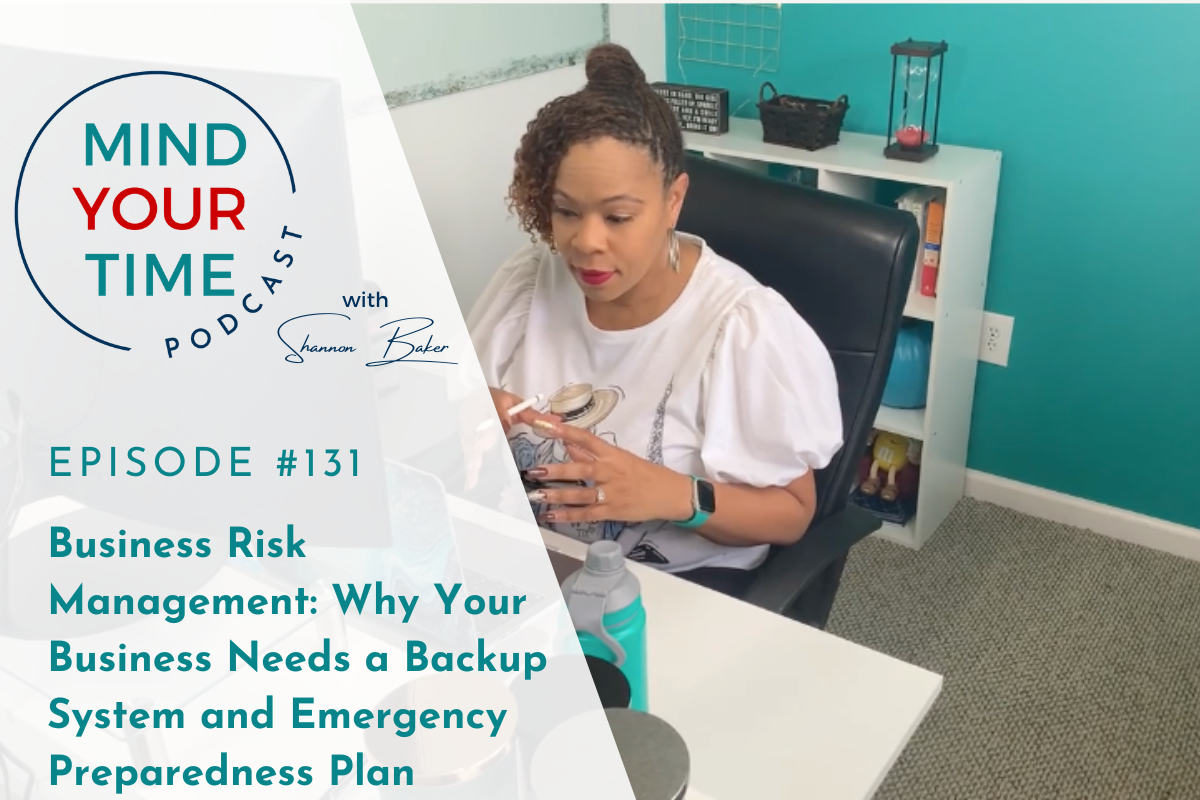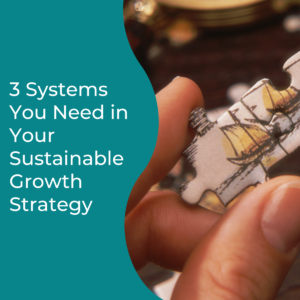As an entrepreneur, you pour your heart and soul into building your business. But do you have a business risk management plan in place to protect it from unforeseen events?
I know how stressful it can be when an emergency happens. Then you have to step away from your business to handle it. I also have seen clients go into a tailspin when a member of their team is out. Whether it’s planned or not, and they need something done for their business.
That’s why today we’re going to talk about a topic that’s often overlooked by many entrepreneurs so you can be prepared.
It’s very easy to get caught up in the day-to-day operations of your business. It’s hard to take time to think about potential risks that could impact your business. This is definitely the case when you are a team of one. But the reality is that there are many risks that you need to be aware of, such as power outages, internet outages, natural disasters, personal illness, family emergencies, and cyber attacks.
According to the Small Business Association, an estimated 25 percent of businesses do not reopen after major disasters like the loss of data or security breaches, or even after natural disasters and electrical fires. That’s why it’s important to understand the risks that your business faces. That way you can take proactive steps to mitigate those risks.
Why you need business risk management?
When you own your own business, an emergency that requires you to step away from your business can be stressful. By taking the time to identify potential vulnerabilities and areas for improvement in your current operations in advance, you can create a backup plan and an emergency preparedness plan that will help your business survive and thrive without you.
When an unexpected emergency or situation arises, your business is the last thing on your mind and you don’t have the mental space to deal with the emergency and your business. Not to mention, some emergencies may mean you are not physically able to speak. Some call that a “hit by the bus” scenario.”
So while your mind is clear you need to prepare your business for the unexpected.
The last thing you want is for a personal crisis, whether it’s yours or a member of your team. This can cause a domino effect that becomes a business crisis that brings an end to your business. That’s why business risk management is so important.
It’s important to understand the risks that your business faces. Then you can take proactive steps to mitigate those risks. That’s why you need a backup plan and an emergency preparedness plan for your business.
Life can change very quickly and those unexpected changes can have long-lasting even devastating effects. And when that happens, you can’t think clearly or make good decisions. That’s why you need to have a clear plan of action that can be implemented. It’s like a break the glass in an emergency type of situation. When you don’t have a plan, you risk facing consequences. You can lose important data, lose clients, and even have your business shut down completely.
How do you figure out what you need?
You need to complete a wholistic audit of your business operations. You must identify potential vulnerabilities and areas for improvement in your current operations and then you need to fix them. And you need to do this before an emergency arises. I can’t emphasize that enough.
Ask yourself questions such as:
“What would happen if I were unable to work for a month?”
“What would happen if my website went down for a day?”
These types of questions will help you identify potential vulnerabilities in your business. Then you can take proactive steps to address them in your business risk management plan.
The great part is you don’t have to Google anything or try to go this audit on your own. A back office assessment is a great place to start. We look at your lifestyle goals, your business goals, your current operations and pull it all together so that we can get them to work in harmony with each other.
You get a custom action plan that can help you understand the areas where you need to focus your efforts. It will also identify areas where you can improve your systems and processes, increase productivity, and reduce the risk of errors or mismanagement. It will also identify any critical systems or data that you need to protect and identify how you can do that.
If you want to hear more about the assessment and the custom action plan that you receive which will identify the gaps in your business operations which are hurting your bottom line, then click here. I walk you through the entire process of booking a back office assessment and talk about what you can expect on that two hour call.
After you book a back office assessment, it is vital that you take action and implement the plan you receive. Otherwise you’ve wasted your time and money. Click here to learn more about the three implementation options available to implement your custom action plan. You can also go to theshannonbaker.com/assessment for more information.
What is a Backup System?
One of the key components of business risk management is creating a backup plan. In a nutshell, a backup system is Plan B to keep your business running. And there are multiple areas you need to have a backup plan in place for. Your computer files is the first one.
I cannot stress this point enough…do not store business documents you use to run your business on your hard drive.
Why? Because that means you’re the only person that can access that information. Not to mention you will lose everything if your hard drive crashes and dies. And take my word for it. You don’t want to experience this! I had this happen to me twice. What saved me from losing years of work? Having everything stored in Google Drive and Dropbox.
And this is very critical, if you plan to hire a virtual assistant or anyone else in the future for that matter. They need access to the files so that they can complete their work. And you don’t want to be the bottleneck because the document they need is on your hard drive.
Your digital filing system is one of the core systems your business needs. That’s why we focused on cleaning up our digital workspaces on Day 2 of the Spring Cleaning Your Business Audio Challenge inside The MY-T Society membership. Feel free to join us at any time. The challenge is still available for current members.
You also need a backup process in place for your website and your blog content. Let me tell you, I have experienced my email and my website being hacked and it wasn’t fun to get that cleaned up. But because I had backups, my website was able to be cleaned and put back in order because the backups were not infected so I was able to upload the content and keep things moving. If you do not backup your files that cannot happen.
The same goes for your CRM contacts, I recommend you download your email subscribers at least once a quarter, and no less than twice a year. This gives you that parachute in the event something happens to your email marketing platform, you do not lose all of your contacts.
Don’t forget to have a backup plan for people
When you start outsourcing, you definitely need to have a plan B for when that person is out. So for instance, if you have a virtual assistant who handles some major tasks like following up with clients, responding to emails, pitching you to be a guest on podcasts, sorting your inbox, etc. What happens when that person is on vacation? Everything should not come to a screeching halt.
But if you have not identified what Plan B is in that instance, then you’re going to have some problems. So identify that backup process in advance. Is there another person that can handle some of these tasks while they’re away so they dont get backed up. Or do you plan on adjusting your schedule during that time to ahdnel those tasks yourself until they return. You need to think about that and document it.
Your backup plan works hand in hand with an emergency preparedness plan. Both are needed for your business to keep running smoothly for a temporary period of time, when, not if you have to step away.
How do you create an Emergency Preparedness Plan?
Start by creating a notebook for your emergency preparedness plan. Yes, you need an electronic copy and a hard copy of your plan. That way if need be, the notebook can be retrieved from your office and put into play. While I am a huge proponent of digital files, you never know when you may need important information printed on old fashioned paper. So that also means you need to store this binder in a location that can be easily found when needed.
Your plan should include all of the details someone will need to keep your company operating while you are away.
This would include:
* Your detailed company information
* Legal documents for your business including a copy of your business license
* Bank account information
* Tax information
* Insurance documents
* List of business assets
* List of your business accounts and passwords (or the master password to your digital password keeper)
* List of business expenses
* An organization chart that identifies all of your teammates, their roles and their contact information
* Your brand information (colors and fonts – branding board)
* Client list with contact information and contracts
* Your SOPs which we’re going to discuss next.
* Document your standard processes and procedures
Create a specific process that explains the immediate actions to be taken in your absence including notifying your clients and your Dream Team. And they should know what actions they need to take in case of an emergency. So that means you should have had this “in case of emergency” conversation with them already.
And this binder should include a printed copy of your standard SOPs. This is another reason for you to book a back office assessment. As we work together to implement the action plan you receive, your Emergency Preparedness plan is also being created.
Who should know about your Emergency Preparedness Plan?
Your spouse should know about your notebook and you also need to designate a biz bestie, so someone you can trust with the keys to your business. And their contact information needs to be included in the plan.
Having one point of contact enables you to make one phone call and they can step in and take over from there. While they can’t do everything that you would do, they can notify your clients of the situation, postpone your meetings and respond to e-mails as needed according to your emergency preparedness plan.
So this means you need to have a conversation with your POC before they are needed, give them access to your SOP ahead of time, let them know where you keep the emergency preparedness binder and have a mutual understanding about what they will do if they need to step in for you for a short period of time.
Then once your emergency preparedness plan is in place, test it with your main point of contact to see how well it’s likely to perform in the event of an emergency. Think about the things that would cause the most disruption and that are most likely to happen to your business. Then make sure that your plan covers each of the risks. Make some telephone calls to check that the key contacts and phone numbers that you have included are correct.
No one wants the worst to happen but sometimes it just does. Being prepared makes the unexpected more manageable, and reduces downtime because your emergency preparedness plan can be implemented to keep things going until you can return. That also means you can continue to generate income which gives you piece of mind to deal with your emergency situation.
One more thing – don’t forget to keep your plan updated! It is a futile point of reference if the information in your plan is out of date. So be sure to review your plan at least once a year, especially contact information that is included in case phone numbers or email addresses change.
So let’s review everything we’ve talked about today to make sure you and your business are prepared for an emergency.
* Having a backup system and emergency preparedness plan is crucial for the success and longevity of your business
* Conducting an audit of your business operations can help identify potential vulnerabilities and areas for improvement
* A backup plan is needed for computer files, website and blog content, CRM contacts, and people, especially when outsourcing to ensure continuity of your operations
* An emergency preparedness plan needs to be created now and should include all necessary details to keep your business running smoothly when you are away
* Your spouse and a trusted biz bestie should be designated as your point of contact in case of an emergency
In conclusion, having a backup system and emergency preparedness plan in place is critical for the success and longevity of your business. The truth is that unexpected emergencies can and do happen, and without proper preparation, they can lead to the end of your business.
However, with a solid plan in place, you can keep your business running smoothly even when you are away, reducing downtime and keeping your clients happy. If you’re ready to take the first step in protecting your business, then book a back office assessment today. The custom action plan you receive will help you identify the gaps in your business operations that may be hurting your bottom line, and give you the tools to create a plan that will keep your business running, no matter what.
Remember, being prepared is the key to success in business and life, so don’t wait until it’s too late. Start planning today!
Links mentioned in this episode:
Episode 124 – Why You Need a Digital Filing System and How to Create One
Episode 127 – What is a Back Office Assessment
Episode 128 – How to Use An Action Plan to Strategically Prepare For Business Growth
Check Out The MY-T Society Membership
Let’s connect online
Connect With Me On Instagram: @the_shannonbaker





Pingback: Top Tips to Master Work-Life Integration with Digital Calendars -
Pingback: 6 Basic Systems Every Business Needs to Be Efficient and Profitable -